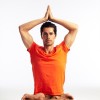I first discovered yoga over 25 years ago.
My discovery was like that of many others in the West who find their way into this world, in that it was defined by my pursuit of the physical postures. I was working out in a gym and wanted to distract myself with a new form of exercise. I would go to yoga studios in whatever city I was in and grunt my way through many different sequences that usually induced soreness and a lot of sweat.
When others found out that I practiced yoga, the first question they usually asked was, “Where do you take yoga classes?” I might have told them that I practice at Integral Yoga, Sivananda Yoga, or Siddha Yoga. Some time later, I was asked if I ever did “that hot yoga,” which of course was an outsider’s way of asking if I practiced Bikram. I did take one class back in the 90’s to see what it was like, but never went back again.
What I experienced back then is very common on several levels. When someone in the West is introduced to yoga, it’s usually through the pursuit of the physical postures so commonly known today. Whether someone starts to go to yoga studios after work, takes classes at their gym, or even practices along with a video, they focus most of their attention on a physical routine.
What is also common, however, is for one person to ask another person what style of yoga they practice. In this question, one embraces the idea that yoga postures aren’t a simple series of exercises that everyone does in a similar way.
Their question is likely driven by their wanting to know whether the other person practices a routine inspired by Vinyasa yoga at a place like Jivamukti, Hatha yoga at a place like Integral Yoga, Kundalini at a place like Yoga West, or by specific personalities like B.K.S. Iyengar, Pattabhi Jois, or Bikram Choudhury. And while both people might recognize a shared interest in seeking this physical discipline as an ancient practice grounded in the most sacred spiritual traditions of the Indian tradition, if they practice different styles they likely see themselves as different categories of people as well.
In the years following my introduction to yoga postures, I found other ways to explore my practice. I went on retreats to obscure places in which we attempted to meditate, I committed myself to fasting, I sat in silence for weeks, and I chanted in community sessions like kirtans. But these efforts were far less consistent than the physical act of practicing postures—until about ten or so years after my introduction.
Over the years I had learned how the practice of Yoga centers not on one of many different approaches to developing the body but on liberating the mind from the body. But, I never found the discipline to truly pursue this aspect of it at the time. It was ten years after my introduction when I went from doing yoga to following the Yogic path.
An afflicted mind seeks the outer world to attain a sense of contentment and peace, which is evidenced by those of us who are excessive in our lifestyle. We mistakenly perceive that we will be happy if and when we get more things. But a similar sense of materialism can be assigned to those who attach themselves to a certain style of yoga postures.
Postures were never supposed to become the centerpiece of the entire practice and it was only through the ego that people started to focus on them. As a result, more postures have been invented in the last few centuries.
While Yoga as a tradition is intended to teach us how to liberate our mind from the body, through these attachments we’re trying as hard as possible to stay in it!
This conundrum underlines Yoga’s importance. If we remain attached to a certain style of yoga postures, we remain attached to the material aspect of our existence. When we’re no longer attached to this aspect, we’re able to use Yoga for its intended purpose and live in a state of supreme joy as a result.
We’re able to enjoy the health and vitality that a balanced physical regimen inspires, but we don’t get attached to one specific approach to that regimen over the other. We look at postures, meditation, and everything else born from these traditions as tools for ending a perpetual state of suffering and moving closer to pure consciousness. And once we attain that state, we no longer concern ourselves with whether someone practices the same style as us or not.
We move from using a physical exercise to become spiritual to knowing we are spiritual and using the physical aspect to keep our body as healthy as possible. With a healthy body, we’re able to more fully immerse ourselves in our practice.
Want 15 free additional reads weekly, just our best?
Get our weekly newsletter.
Editor: Dana Gornall
Photo Credit: Flickr Creative Commons

 Share on bsky
Share on bsky






Read 2 comments and reply